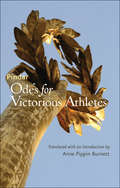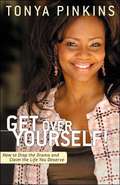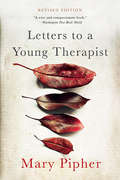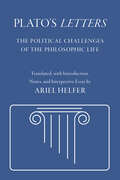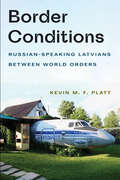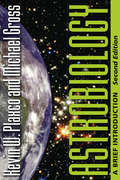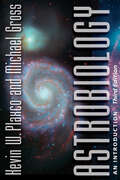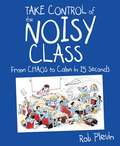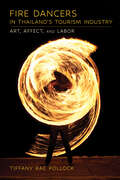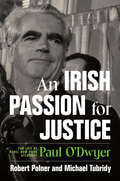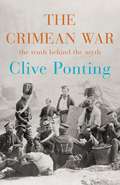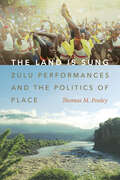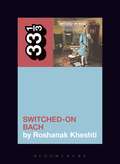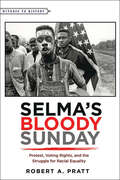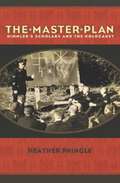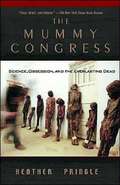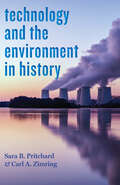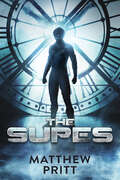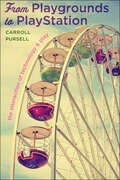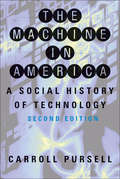- Table View
- List View
Odes for Victorious Athletes (Johns Hopkins New Translations from Antiquity)
by PindarYou've just won the gold medal, what are you going to do? In Ancient Greece, your patron could throw a feast in your honor and have a poet write a hymn of praise to you. The great poet Pindar composed many such odes for victorious athletes. Esteemed classicist Anne Pippin Burnett presents a fresh and exuberant translation of Pindar's victory songs.The typical Pindaric ode reflects three separate moments: the instant of success in contest, the victory night with its disorderly revels, and the actual banquet of family and friends where the commissioned poem is being offered as entertainment. In their essential effect, these songs transform a physical triumph, as experienced by one man, into a sense of elation shared by his peers—men who have gathered to dine and to drink.Athletic odes were presented by small bands of dancing singers, influencing the audience with music and dance as well as by words. These translations respect the form of the originals, keeping the stanzas that shaped repeating melodies and danced figures and using rhythms meant to suggest performers in motion.Pindar's songs were meant to entertain and exalt groups of drinking men. These translations revive the confident excitement of their original performances.
Get Over Yourself!: How to Drop the Drama and Claim the Life You Deserve
by Tonya PinkinsMost of us think we know what we want, and even why we can't get it. In her frank and inspiring book, Tonya Pinkins, star of television and Broadway, shows readers techniques and exercises that help them develop their own processes for obtaining their goals. This is tough love, Tonya style.In addition to being an actress and singer, Tonya has helped hundreds of people with her catalytic motivational seminars. She herself has seen the heights and the depths: from teen star to Tony Award winner to divorced mother on welfare to spiritual student to soaring success and unstoppable celebrity, delivering her magnificent solo performance at the 2004 Tony Awards show. In Get Over Yourself!, she takes the principles that helped her to succeed and puts them into a book that reaches out and grabs readers searching for a better way of life.
Letters to a Young Therapist: Stories Of Hope And Healing By The Author Of The Bestselling Surviving Ophelia (Letters To A Young... Ser.)
by Mary PipherFrom "one of America's best-known psychologists" (Chicago Tribune) and the bestselling author of Women Rowing North and Reviving Ophelia, an essential and inspiring book for therapists and anyone seeking to live a good lifeMary Pipher's groundbreaking investigation of America's "girl-poisoning culture," Reviving Ophelia, established its author as one of the nation's foremost authorities on family issues. In Letters to a Young Therapist, Pipher shares what she has learned in thirty years of clinical practice, helping warring families, alienated adolescents, and harried professionals restore peace and beauty to their lives. Through an exhilarating mix of storytelling and sharp-eyed observation, Pipher reveals her refreshingly inventive approach to therapy-fiercely optimistic, free of dogma or psychobabble, and laced with generous warmth and practical common sense. Whether she's recommending daily swims for a sluggish teenager, encouraging a timid husband to become bolder, or simply bearing witness to a bereaved parent's sorrow, Pipher's compassion and insight shine from every page. With a preface by the author addressing recent changes in therapy and the surprising challenges of the digital age, Letters to a Young Therapist is a powerfully engaging guide to living a healthy life.
Plato's "Letters": The Political Challenges of the Philosophic Life (Agora Editions)
by PlatoIn Plato's "Letters", Ariel Helfer provides to readers, for the first time, a highly literal translation of the Letters, complete with extensive notes on historical context and issues of manuscript transmission. His analysis presents a necessary perspective for readers who wish to study Plato's Letters as a work of Platonic philosophy. Centuries of debate over the provenance and significance of Plato's Letters have led to the common view that the Letters is a motley collection of jewels and scraps from within and without Plato's literary estate. In a series of original essays, Helfer describes how the Letters was written as a single work, composed with a unity of purpose and a coherent teaching, marked throughout by Plato's artfulness and insight and intended to occupy an important place in the Platonic corpus. Viewed in this light, the Letters is like an unusual epistolary novel, a manner of semifictional and semiautobiographical literary-philosophic experiment, in which Plato sought to provide his most demanding readers with guidance in thinking more deeply about the meaning of his own career as a philosopher, writer, and political advisor.Plato's "Letters" not only defends what Helfer calls the "literary unity thesis" by reviewing the scholarly history pertaining to the Platonic letters but also brings out the political philosophic lessons revealed in the Letters. As a result, Plato's "Letters" recovers and rehabilitates what has been until now a minority view concerning the Letters, according to which this misunderstood Platonic text will be of tremendous new importance for the study of Platonic political philosophy.
Border Conditions: Russian-Speaking Latvians between World Orders (NIU Series in Slavic, East European, and Eurasian Studies)
by Kevin M. PlattBorder Conditions combines history and memory studies with literary and cultural studies to examine lives at the limits of contemporary Europe: Russian speakers living in Latvia. Since the fall of the USSR in 1991, Latvia's Russian speakers have balanced between Russia and Europe as well as a socialist past, a capitalist and liberal present, and an illiberal regime rising in the Russian Federation. Kevin M. F. Platt describes how members of this population have defined themselves through art, literature, cultural institutions, film, and music—and how others have sought to define them. At the end of the Cold War, many anticipated that societies globally could agree on the meaning of past history and a just politics in the present. The view from the borders of Europe demonstrates the contradictions pertaining to terms like empire, state socialism, liberalism, and nation that have made it impossible to achieve a consensus. In refocusing the examination of state socialism's aftermath around questions of empire and postcolonialism, Border Conditions helps us understand the distinctions between Russian and Western worldviews driving military confrontation to this day.
Astrobiology: A Brief Introduction
by Kevin W. Plaxco Michael GrossInformed by new planetary discoveries and the findings from recent robotic missions to Mars, Jupiter, and Saturn, scientists are rapidly replacing centuries of speculation about potential extraterrestrial habitats with real knowledge about the possibility of life outside our own biosphere—if it exists, and where. This second edition of Kevin W. Plaxco and Michael Gross’s widely acclaimed text incorporates the latest research in astrobiology to bring readers the most comprehensive, up-to-date, and engaging introduction to the field available.Plaxco and Gross expand their examination of the origin of chemical elements, the developments that made the Universe habitable, and how life continues to be sustained. They discuss in great detail the formation of the first galaxies and stars, the diverse chemistry of the primordial planet, the origins of metabolism, the evolution of complex organisms, and the feedback regulation of Earth's climate. They also explore life in extreme habitats, potential extraterrestrial habitats, and the current status of the search for extraterrestrial life.Weaving together the relevant threads of astronomy, geology, chemistry, biophysics, and microbiology, this broadly accessible introductory text captures the excitement, controversy, and progress of the dynamic young field of astrobiology. New to this edition is a glossary of terms and an epilogue recapping the key unanswered questions, making Astrobiology an ideal primer for students and, indeed, for anyone curious about life and the Universe.
Astrobiology: An Introduction
by Kevin W. Plaxco Michael GrossExploring the potential for extraterrestrial life and the origins of our own planet, this comprehensive introduction to astrobiology is updated with the latest findings.Informed by the discoveries and analyses of extrasolar planets and the findings from recent robotic missions across the solar system, scientists are rapidly replacing centuries of speculation about potential extraterrestrial habitats with real knowledge about the possibility of life outside our own biosphere—if it exists, and, if so, where. Casting new light on the biggest questions there are—how did we get here, and who else might be out there?—this third edition of Kevin W. Plaxco and Michael Gross's widely acclaimed Astrobiology incorporates a decade's worth of new developments in space to bring readers the most comprehensive, up-to-date, and engaging introduction to the field available.Plaxco and Gross examine the factors that make our Universe habitable, from the origin of chemical elements and the formation of the first galaxies and stars to the birth and composition of the planets. They describe the latest thinking about the origins of life, explain the evolution of metabolism and the development of complex organisms. In order to assess the limits for life elsewhere, they also explore life in extreme habitats and reveal how it informs the search for potential extraterrestrial habitats—ones that might support extraterrestrial life. New and updated illustrations enhance the book throughout.Sharing fascinating findings from the comet mission Dawn, the visit of New Horizons to Pluto, and the work of the Deep Carbon Observatory, which has revealed an incredible underground biosphere within our own planet, Plaxco and Gross weave together cosmology, astrophysics, geology, biochemistry, biophysics, and microbiology. From neutron star mergers to the survival skills of tardigrades, this fascinating book is an ideal primer for students or anyone curious about life and the Universe.
Astrobiology: An Introduction
by Kevin W. Plaxco Michael GrossExploring the potential for extraterrestrial life and the origins of our own planet, this comprehensive introduction to astrobiology is updated with the latest findings.Informed by the discoveries and analyses of extrasolar planets and the findings from recent robotic missions across the solar system, scientists are rapidly replacing centuries of speculation about potential extraterrestrial habitats with real knowledge about the possibility of life outside our own biosphere—if it exists, and, if so, where. Casting new light on the biggest questions there are—how did we get here, and who else might be out there?—this third edition of Kevin W. Plaxco and Michael Gross's widely acclaimed Astrobiology incorporates a decade's worth of new developments in space to bring readers the most comprehensive, up-to-date, and engaging introduction to the field available.Plaxco and Gross examine the factors that make our Universe habitable, from the origin of chemical elements and the formation of the first galaxies and stars to the birth and composition of the planets. They describe the latest thinking about the origins of life, explain the evolution of metabolism and the development of complex organisms. In order to assess the limits for life elsewhere, they also explore life in extreme habitats and reveal how it informs the search for potential extraterrestrial habitats—ones that might support extraterrestrial life. New and updated illustrations enhance the book throughout.Sharing fascinating findings from the comet mission Dawn, the visit of New Horizons to Pluto, and the work of the Deep Carbon Observatory, which has revealed an incredible underground biosphere within our own planet, Plaxco and Gross weave together cosmology, astrophysics, geology, biochemistry, biophysics, and microbiology. From neutron star mergers to the survival skills of tardigrades, this fascinating book is an ideal primer for students or anyone curious about life and the Universe.
Take Control Of The Noisy Class: From Chaos To Calm In 15 Seconds (PDF)
by Rob PlevinDo you struggle to get students to listen in your lessons? Do you find students dragging their heels to your lessons only to battle with you from bell to bell? Are you fed up with students who talk over you and ignore your instructions? Are you tired, drained and worn out because of low level disruption, disobedience and defiance? Do you long for a workable, practical system to help you take control and enjoy stress--free teaching? If you answered 'yes' to any of those questions you'll love the highly effective, proven strategies in Take Control of the Noisy Class! Teacher--trainer Rob Plevin explains a clear, step--by--step plan for successfully managing the most challenging individuals and groups in today's toughest classrooms. Written in a friendly and accessible style, and packed with powerful, fast--acting techniques -- including a novel tactic to get any class quiet in 15 seconds or less -- this book helps teachers transform their ability to connect and succeed with hard--to--reach, reluctant learners. Even if you have never had 'the class from hell', you'll find hundreds of practical, useable ideas and interventions to meet students' needs and create a thoroughly enjoyable classroom climate for all concerned. Take Control of the Noisy Class! provides teachers with a proven system for dealing with disruptive, inappropriate behaviour in the classroom, enabling them to create calm, positive learning environments and trusting bonds with hard--to--reach students. Discover: effective behaviour management strategies, the power of routines, instructions and consequences, the importance of relationships, tips and tricks for tackling misbehaviour, proven techniques for getting a rowdy class's attention, strategies for maintaining lesson flow and a positive learning environment and effective classroom management strategies which curb misbehaviour and prevent it reaching the stage of involving the senior leadership team and school behaviour policy. Super--effective classroom management strategies for today's toughest classrooms. Relevant to teachers of all subjects and age groups - across primary and secondary schools. Ideal for individual teachers and leaders or as the basis of whole--school.
What Your Doctor May Not Tell You About(TM) (TM) (TM) (TM) (TM) (TM) (TM) (TM): Colorectal Cancer: New Tests, New Treatments, New Hope
by Mark Bennett PochapinOver 50,000 men and women die from colorectal cancer each year - a particularly alarming statistic since it is also one of the most preventable and treatable cancers. In fact, it is estimated that over one-third of colorectal cancer deaths could have been avoided. Now, there's hope. Contains important information on beating colorectal cancer, including the six biggest lifestyle threats, the three nutritional supplements anyone at risk should take, the optimal timeframe for screenings, the pros and cons of new detection tests, and how to effectively treat cancerous and pre-cancerous polyps with both traditional and alternative methods.
Fire Dancers in Thailand's Tourism Industry: Art, Affect, and Labor
by Tiffany Rae PollockFire Dancers in Thailand's Tourism Industry explores the evolution of fire dancing from informal community jam sessions into the iconic, tourist-oriented performances at beach parties and bars, through a close consideration of the role of affect in the lives of fire dancers in the ever-changing scene. Rather than pursuing the common notion that tourism industries are exploitative enterprises that oppress workers, Tiffany Rae Pollock centers the perspectives of fire artists themselves, who view the industry as simultaneously generative and destructive. Dancers reveal how they employ affect to navigate their lives, art, and labor in this context, showcasing how affect is not only a force that acts on people but also is used and shaped by social actors toward their own ends. Fire Dancers in Thailand's Tourism Industry highlights men as affective laborers, investigating how they manage the eroticization of their identities and the intersections of art and labor in tourist economies. Exploring moments of performance and everyday life, Pollock examines how fire artists reimagine their labor, lives, and communities in Thailand's tourism industry.
An Irish Passion for Justice: The Life of Rebel New York Attorney Paul O'Dwyer
by Robert Polner Michael TubridyAn Irish Passion for Justice reveals the life and work of Paul O'Dwyer, the Irish-born and quintessentially New York activist, politician, and lawyer who fought in the courts and at the barricades for the rights of the downtrodden and the marginalized throughout the 20th century.Robert Polner and Michael Tubridy recount O'Dwyer's legal crusades, political campaigns, and civic interactions, deftly describing how he cut a principled and progressive path through New York City's political machinery and America's reactionary Cold War landscape. Polner and Tubridy's dynamic, penetrating depiction showcases O'Dwyer's consistent left-wing politics and defense of accused Communists in the labor movement, which exposed him to sharp criticism within and beyond the Irish-American community. Even so, his fierce beliefs, loyalty to his brother William, who was the city's mayor after World War II, and influence in Irish-American circles also inspired respect and support. Recognized by his gentle brogue and white pompadour, he fought for the creation of Israel, organized Black voters during the Civil Rights movement, and denounced the Vietnam War as an insurgent Democratic candidate for US Senate. Finally, he enlisted future president Bill Clinton to bring an end to the Troubles in Northern Ireland. As the authors demonstrate, O'Dwyer was both a man of his time and a politician beyond his years.An Irish Passion for Justice tells an enthralling and inspiring New York immigrant story that uncovers how one person, shaped by history and community, can make a difference in the world by holding true to their ideals.
The Crimean War: The Truth Behind the Myth
by Clive PontingThe Crimean War is full of resonance - the battles of Alma, Balaclava and Inkerman, the Charge of the Light Brigade, the siege of Sevastopol, Florence Nightingale at Scutari with her lamp. To contemporaries, it was not the Crimean War but 'The Great War with Russia' - ironically Britain's allies were France, her traditional enemy, and the Ottoman Empire, widely seen as an infidel, corrupt Islamic power. Britain was unable fully to deploy her greatest strength, the Royal Navy, while her army was run by incompetent aristocrats. With his sharp eye and analytical mind, Clive Ponting explodes many of the romantic myths which grew up in the years following the war, while telling the true story of the heroism of ordinary men. Above all, he makes use of the testimony of eye-witness accounts, from William Russell of The Times, the first war correspondent, to Leo Tolstoy, who was caught up in the action while visiting his brother, to the memories of a variety of serving soldiers.
The Crimean War: The Truth Behind the Myth (PDF)
by Clive PontingThe Crimean War is full of resonance - the battles of Alma, Balaclava and Inkerman, the Charge of the Light Brigade, the siege of Sevastopol, Florence Nightingale at Scutari with her lamp. To contemporaries, it was not the Crimean War but 'The Great War with Russia' - ironically Britain's allies were France, her traditional enemy, and the Ottoman Empire, widely seen as an infidel, corrupt Islamic power. Britain was unable fully to deploy her greatest strength, the Royal Navy, while her army was run by incompetent aristocrats. With his sharp eye and analytical mind, Clive Ponting explodes many of the romantic myths which grew up in the years following the war, while telling the true story of the heroism of ordinary men. Above all, he makes use of the testimony of eye-witness accounts, from William Russell of The Times, the first war correspondent, to Leo Tolstoy, who was caught up in the action while visiting his brother, to the memories of a variety of serving soldiers.
The Land Is Sung: Zulu Performances and the Politics of Place (Music / Culture)
by Thomas M. PooleyWhat does it mean to belong? In The Land is Sung, musicologist Thomas M. Pooley shows how performances of song, dance, and praise poetry connect Zulu communities to their ancestral homes and genealogies. For those without land tenure in the province of KwaZulu-Nata, performances articulate a sense of place. Migrants express their allegiances through performance and spiritual relationships to land are embodied in rituals that invoke ancestral connection while advancing well-being through intergenerational communication. Engaging with justice and environmental ethics, education and indigenous knowledge systems, musical and linguistic analysis, and the ethics of recording practice, Pooley's analysis draws on genres of music and dance recorded in the midlands and borderlands of South Africa, and in Johannesburg's inner city. His detailed sound writing captures the visceral experiences of performances in everyday life. The book is richly illustrated and there is a companion website featuring both video and audio examples.
Witch Switch (Witch Wars)
by Sibéal Pounder_______________'This is a witch story like no other – and it's a blast!' – Bookseller'Brilliantly magical' – Tom Fletcher Book Club_______________The second book in the hilarious Witch Wars series for kids aged 7+, perfect for fans of The Worst Witch.Tiga Whicabim is settling in to the witchy, glitzy world of Ritzy City. Peggy is Top Witch, and Tiga is enjoying life at the Brews' house with Fluffanora. But when Fran the Fabulous Fairy visits Linden House and finds Peggy has gone – leaving behind only a note to say she is 'AWAY WITH THE FAIRIES' and has left the evil Felicity Bat in charge – the girls realise something is very wrong. And then witches all across town start to disappear. Tiga and Fluffanora set out to investigate and discover an old, unsolved Sinkville mystery that might just be the key to it all.
Selma;€™s Bloody Sunday: Protest, Voting Rights, and the Struggle for Racial Equality (Witness to History)
by Robert A. PrattOn Sunday afternoon, March 7, 1965, roughly six hundred peaceful demonstrators set out from Brown Chapel A.M.E. Church in a double-file column to march from Selma, Alabama, to the state capital of Montgomery. Leading the march were Hosea Williams of the Southern Christian Leadership Conference and John Lewis of the Student Nonviolent Coordinating Committee. Upon reaching Broad Street, the marchers turned left to cross the Edmund Pettus Bridge that spanned the Alabama River. "When we reached the crest of the bridge," recalls John Lewis, "I stopped dead still. So did Hosea. There, facing us at the bottom of the other side, stood a sea of blue-helmeted, blue-uniformed Alabama state troopers, line after line of them, dozens of battle-ready lawmen stretched from one side of U.S. Highway 80 to the other. Behind them were several dozen more armed men;¢;‚¬;€?Sheriff Clark;€™s posse;¢;‚¬;€?some on horseback, all wearing khaki clothing, many carrying clubs the size of baseball bats."The violence and horror that was about to unfold at the foot of the bridge would forever mark the day as "Bloody Sunday," one of the pivotal moments of the civil rights movement. Alabama state troopers fell on the unarmed protestors as they crossed the bridge, beating and tear gassing them. In Selma;€™s Bloody Sunday, Robert A. Pratt offers a vivid account of that infamous day and the indelible triumph of black and white protest over white resistance. He explores how the march itself;¢;‚¬;€?and the 1965 Voting Rights Act that followed;¢;‚¬;€?represented a reaffirmation of the nation;€™s centuries-old declaration of universal equality and the fulfillment of the Fifteenth Amendment to the Constitution.Selma;€™s Bloody Sunday offers a fresh interpretation of the ongoing struggle by African Americans to participate freely in America;€™s electoral democracy. Jumping forward to the present day, Pratt uses the march as a lens through which to examine disturbing recent debates concerning who should, and who should not, be allowed to vote. Drawing on archival materials, secondary sources, and eyewitness accounts of the brave men and women who marched, this gripping account offers a brief and nuanced narrative of this critical phase of the black freedom struggle.
Selma;€™s Bloody Sunday: Protest, Voting Rights, and the Struggle for Racial Equality (Witness to History)
by Robert A. PrattOn Sunday afternoon, March 7, 1965, roughly six hundred peaceful demonstrators set out from Brown Chapel A.M.E. Church in a double-file column to march from Selma, Alabama, to the state capital of Montgomery. Leading the march were Hosea Williams of the Southern Christian Leadership Conference and John Lewis of the Student Nonviolent Coordinating Committee. Upon reaching Broad Street, the marchers turned left to cross the Edmund Pettus Bridge that spanned the Alabama River. "When we reached the crest of the bridge," recalls John Lewis, "I stopped dead still. So did Hosea. There, facing us at the bottom of the other side, stood a sea of blue-helmeted, blue-uniformed Alabama state troopers, line after line of them, dozens of battle-ready lawmen stretched from one side of U.S. Highway 80 to the other. Behind them were several dozen more armed men;¢;‚¬;€?Sheriff Clark;€™s posse;¢;‚¬;€?some on horseback, all wearing khaki clothing, many carrying clubs the size of baseball bats."The violence and horror that was about to unfold at the foot of the bridge would forever mark the day as "Bloody Sunday," one of the pivotal moments of the civil rights movement. Alabama state troopers fell on the unarmed protestors as they crossed the bridge, beating and tear gassing them. In Selma;€™s Bloody Sunday, Robert A. Pratt offers a vivid account of that infamous day and the indelible triumph of black and white protest over white resistance. He explores how the march itself;¢;‚¬;€?and the 1965 Voting Rights Act that followed;¢;‚¬;€?represented a reaffirmation of the nation;€™s centuries-old declaration of universal equality and the fulfillment of the Fifteenth Amendment to the Constitution.Selma;€™s Bloody Sunday offers a fresh interpretation of the ongoing struggle by African Americans to participate freely in America;€™s electoral democracy. Jumping forward to the present day, Pratt uses the march as a lens through which to examine disturbing recent debates concerning who should, and who should not, be allowed to vote. Drawing on archival materials, secondary sources, and eyewitness accounts of the brave men and women who marched, this gripping account offers a brief and nuanced narrative of this critical phase of the black freedom struggle.
The Master Plan: Himmler's Scholars and the Holocaust
by Heather PringleA groundbreaking history of the Nazi research institute whose work helped lead to the extermination of millionsIn 1935, Heinrich Himmler established a Nazi research institute called The Ahnenerbe, whose mission was to send teams of scholars around the world to search for proof of Ancient Aryan conquests. But history was not their most important focus. Rather, the Ahnenerbe was an essential part of Himmler's master plan for the Final Solution. The findings of the institute were used to convince armies of SS men that they were entitled to slaughter Jews and other groups. And Himmler also hoped to use the research as a blueprint for the breeding of a new Europe in a racially purer mold.The Master Plan is a groundbreaking exposé of the work of German scientists and scholars who allowed their research to be warped to justify extermination, and who directly participated in the slaughter--many of whom resumed their academic positions at war's end. It is based on Heather Pringle's extensive original research, including previously ignored archival material and unpublished photographs, and interviews with living members of the institute and their survivors.A sweeping history told with the drama of fiction, The Master Plan is at once horrifying, transfixing, and monumentally important to our comprehension of how something as unimaginable as the Holocaust could have progressed from fantasy to reality.
The Mummy Congress: Science, Obsession, and the Everlasting Dead
by Heather PringleMummies, experts, and breaking science revealed in journalist Pringle's fascinating dive into a little-known arena of human studies.Perhaps the most eccentric of all scientific meetings, the World Congress on Mummy Studies brings together mummy experts from all over the globe and airs their latest findings. Who are these scientists, and what draws them to this morbid yet captivating field? The Mummy Congress, written by acclaimed science journalist Heather Pringle, examines not just the world of mummies, but also the people obsessed with them.
Technology and the Environment in History: Nature and Technology in History (Technology in Motion)
by Sara B. Pritchard Carl A. ZimringToday's scientists, policymakers, and citizens are all confronted by numerous dilemmas at the nexus of technology and the environment. Every day seems to bring new worries about the dangers posed by carcinogens, "superbugs," energy crises, invasive species, genetically modified organisms, groundwater contamination, failing infrastructure, and other troubling issues. In Technology and the Environment in History, Sara B. Pritchard and Carl A. Zimring adopt an analytical approach to explore current research at the intersection of environmental history and the history of technology—an emerging field known as envirotech. Technology and the Environment in History They discuss the important topics, historical processes, and scholarly concerns that have emerged from recent work in thinking about envirotech. Each chapter focuses on a different urgent topic: • Food and Food Systems: How humans have manipulated organisms and ecosystems to produce nutrients for societies throughout history.• Industrialization: How environmental processes have constrained industrialization and required shifts in the relationships between human and nonhuman nature.• Discards: What we can learn from the multifaceted forms, complex histories, and unexpected possibilities of waste.• Disasters: How disaster, which the authors argue is common in the industrialized world, exposes the fallacy of tidy divisions among nature, technology, and society.• Body: How bodies reveal the porous boundaries among technology, the environment, and the human.• Sensescapes: How environmental and technological change have reshaped humans' (and potentially nonhumans') sensory experiences over time.Using five concepts to understand the historical relationships between technology and the environment—porosity, systems, hybridity, biopolitics, and environmental justice—Pritchard and Zimring propose a chronology of key processes, moments, and periodization in the history of technology and the environment. Ultimately, they assert, envirotechnical perspectives help us engage with the surrounding world in ways that are, we hope, more sustainable and just for both humanity and the planet. Aimed at students and scholars new to environmental history, the history of technology, and their nexus, this impressive synthesis looks outward and forward—identifying promising areas in more formative stages of intellectual development and current synergies with related areas that have emerged in the past few years, including environmental anthropology, discard studies, and posthumanism.
Technology and the Environment in History: Nature and Technology in History (Technology in Motion)
by Sara B. Pritchard Carl A. ZimringToday's scientists, policymakers, and citizens are all confronted by numerous dilemmas at the nexus of technology and the environment. Every day seems to bring new worries about the dangers posed by carcinogens, "superbugs," energy crises, invasive species, genetically modified organisms, groundwater contamination, failing infrastructure, and other troubling issues. In Technology and the Environment in History, Sara B. Pritchard and Carl A. Zimring adopt an analytical approach to explore current research at the intersection of environmental history and the history of technology—an emerging field known as envirotech. Technology and the Environment in History They discuss the important topics, historical processes, and scholarly concerns that have emerged from recent work in thinking about envirotech. Each chapter focuses on a different urgent topic: • Food and Food Systems: How humans have manipulated organisms and ecosystems to produce nutrients for societies throughout history.• Industrialization: How environmental processes have constrained industrialization and required shifts in the relationships between human and nonhuman nature.• Discards: What we can learn from the multifaceted forms, complex histories, and unexpected possibilities of waste.• Disasters: How disaster, which the authors argue is common in the industrialized world, exposes the fallacy of tidy divisions among nature, technology, and society.• Body: How bodies reveal the porous boundaries among technology, the environment, and the human.• Sensescapes: How environmental and technological change have reshaped humans' (and potentially nonhumans') sensory experiences over time.Using five concepts to understand the historical relationships between technology and the environment—porosity, systems, hybridity, biopolitics, and environmental justice—Pritchard and Zimring propose a chronology of key processes, moments, and periodization in the history of technology and the environment. Ultimately, they assert, envirotechnical perspectives help us engage with the surrounding world in ways that are, we hope, more sustainable and just for both humanity and the planet. Aimed at students and scholars new to environmental history, the history of technology, and their nexus, this impressive synthesis looks outward and forward—identifying promising areas in more formative stages of intellectual development and current synergies with related areas that have emerged in the past few years, including environmental anthropology, discard studies, and posthumanism.
The Supes
by Matthew PrittA group of failed teenage superheroes-in-training must unite not only to prove themselves worthy of the Super title but also to protect their school and loved ones. Readers will be gripped by this book chock-full of quick action and laughs.
From Playgrounds to PlayStation: The Interaction of Technology and Play
by Carroll PursellIn this romp through the changing landscape of nineteenth- and twentieth-century American toys, games, hobbies, and amusements, senior historian of technology Carroll Pursell poses a simple but interesting question: What can we learn by studying the relationship between technology and play? From Playgrounds to PlayStation explores how play reflects and drives the evolution of American culture. Pursell engagingly examines the ways in which technology affects play and play shapes people. The objects that children (and adults) play with and play on, along with their games and the hobbies they pursue, can reinforce but also challenge gender roles and cultural norms. Inventorsâ€�who often talk about "playing" at their work, as if motivated by the pure fun of inventionâ€�have used new materials and technologies to reshape sports and gameplay, sometimes even crafting new, extreme forms of recreation, but always responding to popular demand.Drawing from a range of sources, including scholarly monographs, patent records, newspapers, and popular and technical journals, the book covers numerous modes and sites of play. Pursell touches on the safety-conscious playground reform movement, the dazzling mechanical innovations that gave rise to commercial amusement parks, and the media’s colorful promotion of toys, pastimes, and sporting events. Along the way, he shows readers how technology enables the forms, equipment, and devices of play to evolve constantly, both reflecting consumer choices and driving innovators and manufacturers to promote toys that involve entirely new kinds of playâ€�from LEGOs and skateboards to beading kits and videogames.
The Machine in America: A Social History of Technology
by Carroll PursellFrom the medieval farm implements used by the first colonists to the invisible links of the Internet, the history of technology in America is a history of society as well. Arguing that "the tools and processes we use are a part of our lives, not simply instruments of our purpose," historian Carroll Pursell analyzes technology's impact on the lives of women and men, on their work, politics, and social relationships—and how, in turn, people influence technological development.Pursell shows how both the idea of progress and the mechanical means to harness the forces of nature developed and changed as they were brought from the Old World to the New. He describes the ways in which American industrial and agricultural technology began to take on a distinctive shape as it adapted and extended the technical base of the industrial revolution. He discusses the innovation of an American system of manufactures and the mechanization of agriculture; new systems of mining, lumbering, and farming, which helped conquer and define the West; and the technologies that shaped the rise of cities. In the second edition of The Machine in America, Pursell brings this classic history up to date with a revised chapter on war technology and new discussions on information technology, globalization, and the environment.
